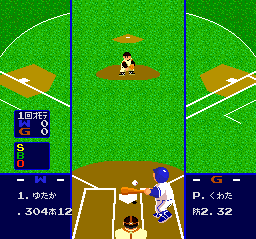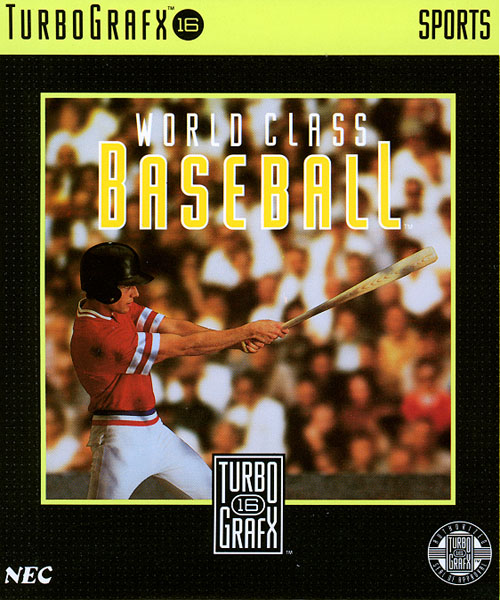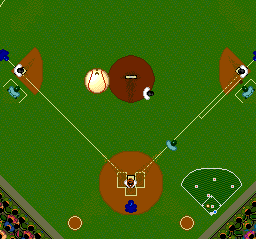HuCARTography VIII: Hardly Sporting
By jeffrud 5 Comments
Pro Yakyuu World Stadium
Developer/Publisher: Namco | Release: 20 May 1988 (JP)
Foreknowledge
Psst. Hey man, check this out. You like that Famista? I got more of that Famista, but without that “Fami” part.

World Stadium is Namco cheekily releasing Famista-style baseball games on any non-Nintendo platform. This started out in the arcades before a couple iterations here on the PC Engine, ultimately becoming a whole line of yakyuu games on Sony platforms in the future.
I’m going to avoid the overwhelming urge to write one simple set of text here to be copy and pasted across every Famista and/or sports title to be covered herein and on NamCompendium. The urge is oh so strong.

Pro Yakyuu Family Stadium was a home baseball video game from 1986 that presented what was, at the time, a presentation of the sport that was pick-up-and-play friendly and cute as hell. The chubby little ballmen of Famista are iconic, influencing a certain subset of Japanese sports games to this day. As for the gameplay, the series shares a hamartia with a fair deal of sports games of its era: the CPU is an absolute bastard. The controls for batting and pitching are straightforward enough, but the game playing itself is better than you are at both of these aspects of the sport of baseball, to say nothing of the sluggish movement of the fielders. The view of the ballpark during defensive plays only reveals most, not all, of the playing field. You are made to rely on a small minimap in the corner of the screen to help position your outfielders for pop flies and short line drives, and all three outfielders move in unison. I am horrible at this, and so are you. Naturally, Pro Yakyuu World Stadium is pretty good at this.
Thus, this series is always best with an equally handicapped opponent: a friend or sibling, preferably of the sort who are interested in thirty five year old baseball video games over MLB The Show. With a level playing field, at least there’s the space for some banter while you both fumble with fielding and throw impossible looking pitches. Solo dolo, these games are Not That Fun.
In short you’ve played one Famista (and to that we can add R.B.I Baseball on the NES) you have pretty well played them all, and should know what's in the tin. Let’s get this over with then, shall we?
Hindsight
In terms of what World Stadium offers over its contemporaneous Famicom games, it’s a rough proposition. On the one hand the sprite work is more detailed, but not so much that you’ll be blown away by the power of Hudson’s machine. The music is the same Famista tracks you know and love, but with that tinny, slightly warbly PCE sound. It has a dozen teams which are related to, if not literal representations of, squads in the domestic Japanese baseball world. That’s neat, but that has been a feature of the series since its original Famicom release in 1986.

That’s just it though. The appeal here is getting a Family Stadium-style ballgame onto the platform, nothing more or less. World Stadium had made its arcade debut prior to this release, and the game was a hit in arcades just as it was on the Famicom. Pro Yakyuu World Stadium was certainly well received on the PC Engine as well. It scored a 35 in Famitsu, which at that early point in the magazine’s life was rarified air reserved for the likes of Dragon Quest, Zelda, and… well, the first Pro Yakyuu Family Stadium. It was enough, domestically anyway, to simply be a version of Namco’s take on the sport on the hot new platform.
Innings Played: 3. I’ve put in my time with these games and for my own sanity I’ve learned to limit my time with them.
Runs Scored: 2. The scores in man vs. machine Famista games are grounded, in the sense that some games are absolute blowouts in real life as well. The AI managed 7 in three innings.
Turbo Ratio: Not Applicable. This isn’t just a function of there not being an overseas release of the game either. Pricecharting.com has zero sales data for World Stadium at time of writing. Copies range from loose for $7 to complete for $25. I bought mine by chance for about $10 in a local shop. The closest thing America ever got to a Famista release, RBI Baseball by Tengen for the NES (a literal reskin of the first Famista game), goes for about $10 as well.
**********
So, NEC and Hudson secured one of Namco’s hottest properties on their hot machine. And as the first sports release on the system, it had plenty of room to breathe and soak up market share in its own crease. No need to worry about competition. No need to release a competing product in the sports genre, or specifically the baseball genre, anytime soon. No sir, it’s World Stadium or bust on the PC Engine here on out. That’s right, Nothing Stupid Is About To Happen In This Space No Siree.
Power League/World Class Baseball
Developer/Publisher: Hudson | Release: 24 June 1988 (JP) / December 1989 (NA)
Foreknowledge

Of all the silly moves that could be made on this platform, by this company, it’s hard to imagine the release of Power League directly after a conversion of Famista being trumped anytime soon. I understand that Japan is one of maybe half a dozen domestic markets on earth that could stomach multiple baseball video games being released in a calendar year, but that’s not really the concern I can identify off the bat (hoho!). It's more the sales cannibalization angle; if the goal is to woo third parties to your non-Nintendo platform with the goal of having them make enough money to stick around – in the process slowly drawing mind share away from Nintendo – why do something that will demonstrably take some of that money away from them?
Like, imagine if you sold hot dogs on a street corner for a fairly nominal rental fee on the space. Then the guy who tolerates you setting up in front of his apartment building suddenly starts charging you $15,000 a month to use the space. Then I come along and offer you a different block that is up and coming but the rent is the same as the old agreement, so you jump over to the new block. Then I set up a hot dog stand directly next to yours with a sign that says my hot dogs are the best on the block no question. I would imagine, in this Tim Robinson-esque scenario, that you would be just a little but fucking furious.
Can I say definitively that this specific release laid the groundwork for there being only two Namco baseball games on the platform versus Hudson’s six? No. But are these phenomenon related? Hmm.
And you want to know the best part?
Hindsight
It’s just another period baseball game. There are differences in visual presentation and game feel from Namco’s product, sure, but not the sort of differences that mean a damn thing in 2023. These are both ancient sports games which hold limited contemporary appeal beyond firing up for the sort of TurboGrafx-16 multiplayer parties dreamed of by only the most perverse YouTube retro gaming personalities.

(It’s worth noting, in both this and the instance above, that the multiplayer in either game is bound to purchasing a separate multitap adapter to expand the PC Engine or TG16 beyond its native single controller bus)
Power League, which did receive a North American release as World Class Baseball (the only baseball game released on the platform over here), errs on the side of realism when compared to Famista derivatives. The player proportions are more anthropomorphic and less chibi, and the score after three innings of baseball was more representative of a typical game in my experience. Perhaps the most notable change beyond aesthetic choices is the shift to a more direct top down perspective during fielding versus the more tilt shifted fielding camera in Namco’s offering. It’s a more grounded, less fanciful video game rendition of a sport which had for years dealt with complaints of being overly protracted and dull. On the other hand, the AI is a bit less brutal than that of Famista/Worldsta (can I coin Worldsta?) and the soundtrack isn’t the same three or four warmed over tracks Namco had already recycled ad nauseum for two years by this point.
It’s no walk (ha! because baseball!) but I’d probably take Power League in this particular fight. I’d also take neither if given the option, thank you very much.
Innings Played: 3. The same three innings I will extend to the dozen odd baseball games on this system, as anything beyond that would imply that I’m enjoying myself.
Successful deep hits fielded: 3. Call it beginner’s luck but the computer opponent liked to pop it way up into left field, leaving me plenty of time to get my ball lad under the ball ball.
Turbo Ratio: 1:2. A complete Japanese copy of Power League goes for $10, half of the $20 going rate of World Class Baseball.
****
Author's Note: Looks like I've failed to link Chris Bucci's Turbo Views videos for the last few available games. Gonna backfill these in the coming days, starting right here and now with his video review of World Class Baseball.
